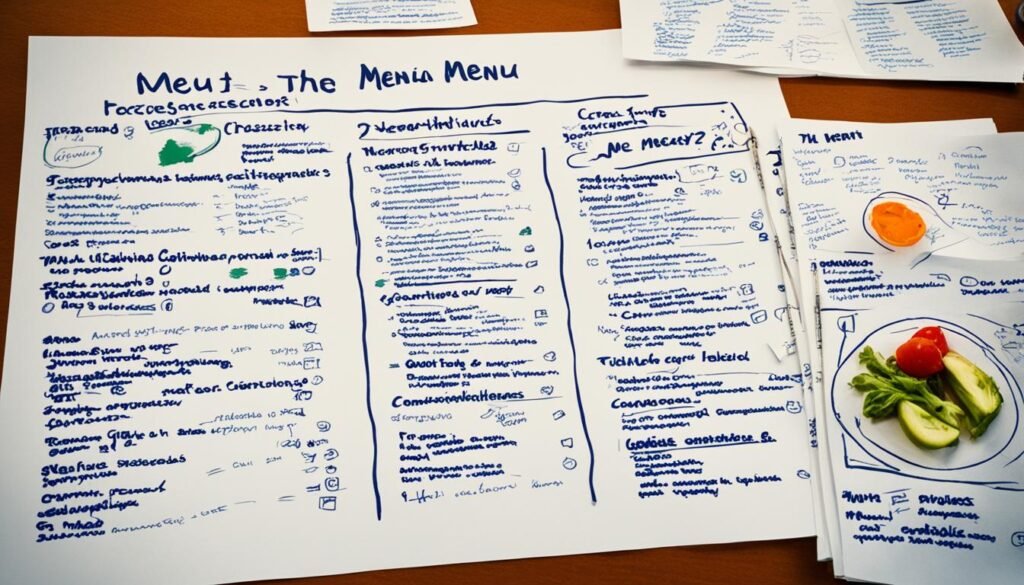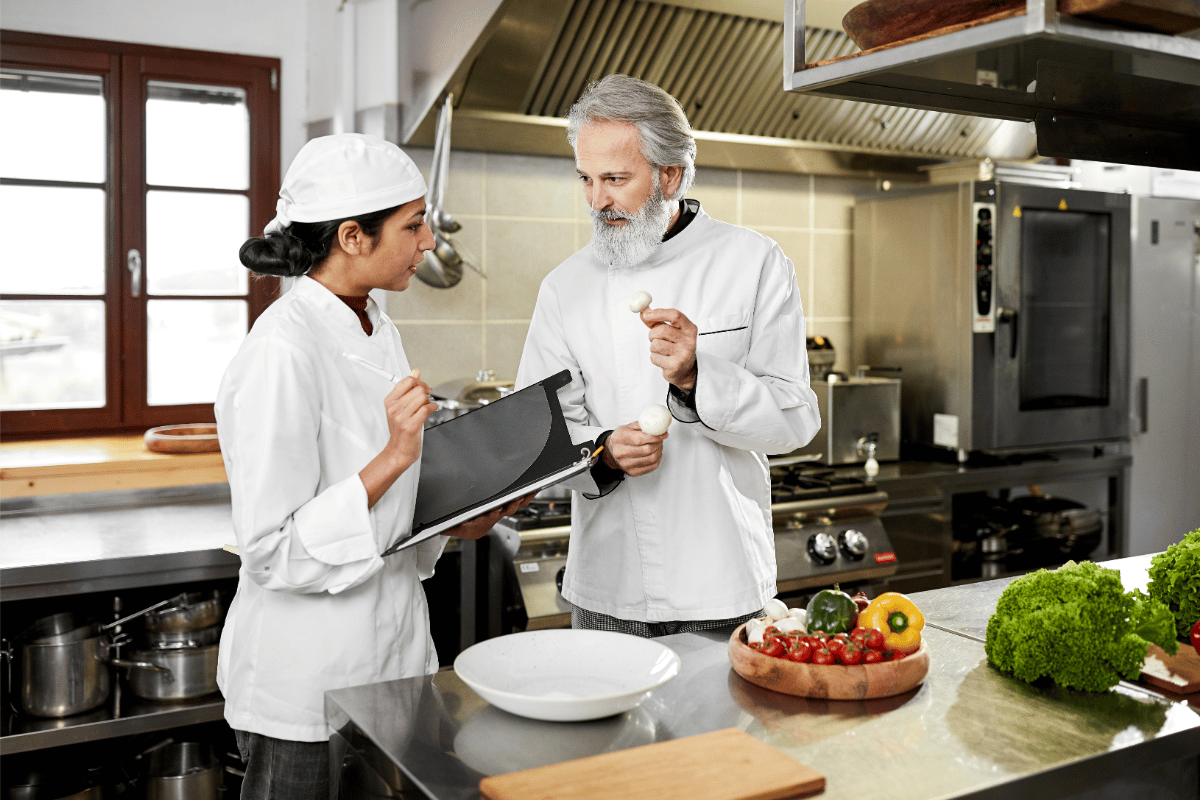Mastering Introduction to Menu Planning and Design
Every restaurant owner knows the importance of a good menu. It’s more than a list of dishes. It shows what the restaurant is all about. It tells the story of its food, style, and the experience it offers.
Picture this: You walk into an Italian trattoria. The menu catches your eye with its warm colors and fancy fonts. It makes you feel like you’re in Rome. Gorgeous pictures of pasta dishes and rich descriptions make you hungry. They promise a delicious meal ahead.
This menu was clearly made with care. It hints at the amazing food journey you’ll soon embark on.
Menu planning and design go beyond looks. They are tools to share a restaurant’s special dishes, draw in customers, and boost sales. With the right menu, you grab your customers’ attention right away. It can lead them to exciting food adventures.
Key Takeaways:
- Developing an attractive menu is key in the restaurant business.
- The choice of colors and fonts can set the right mood and enhance legibility.
- An easy-to-read and well-structured menu can help customers choose and increase sales.
- Using appetizing pictures and engaging dish descriptions can draw customers in.
- Keeping the menu up-to-date is crucial to staying interesting and competitive.
The Importance of Colors and Fonts in Menu Design
Colors and fonts are key in menu design, going beyond just looks. They help make menus stand out and tell a story about the restaurant. Carefully chosen colors and fonts can improve the dining experience and pull in customers more effectively.
Menu Design Principles: Choosing the Right Colors
Menu colors should match the restaurant’s style and who they’re trying to attract. Warm colors like red, orange, and yellow can make people want to eat more. They add energy, perfect for lively places.
Cool colors, such as blues, greens, and purples, bring a calm vibe. They’re great for places that aim for sophistication. Think of your restaurant’s mood and pick colors that match.
Certain colors fit different food types and customer groups. A Mexican spot might use bright colors, while a nature-influenced one would choose calming earth tones.
Font Selection: Readability and Character
Choosing the right font is crucial. It must be easy to read for customers. Use simple, sans-serif fonts like Arial for a clear, modern menu.
But don’t miss the chance to show your restaurant’s style with unique fonts. Mixing in different styles can highlight parts of the menu and add character. This makes your menu special and memorable.
“The right combination of colors and fonts can elevate a menu from simple to stunning, enticing customers to explore the culinary offerings.”
Balancing readability with style is essential for a good menu. It makes sure customers not only understand what you offer but enjoy the menu itself.
Creating an Effective Menu Structure and Layout
The way you plan and design your menu matters a lot. It affects how people enjoy their meal. Making your menu easy to read and find things quickly helps customers choose what to eat. By arranging dishes logically and highlighting important ones, you can guide customers in a smart way.
To make this process even easier, a menu creator app helps you design an easy-to-navigate menu that highlights your best dishes, enhancing both the customer experience and order efficiency.
The Importance of Menu Organization
Menu organization means making it simple for customers to see what you offer. Divide your menu into parts like starters, main courses, and desserts. This makes choosing easier without too many choices at once.
Now, picture a menu that’s just a list without clear parts. It doesn’t seem welcoming and can confuse people. They might find it hard to decide what to order.
“An organized menu is like a roadmap, guiding customers on a culinary journey through your restaurant’s offerings.” – John Thompson, Restaurant Consultant
Optimizing Dish Placement for Customer Attention
Where you put each dish on the menu can change what people order. Highlighting specials or high-profit dishes draws attention. This can boost your sales. You can put these items at the start or end of each section, or near eye-catching images.
But don’t overdo it. Poise your best items to attract interest without forcing the choice. Your menu should offer a select range, not all options.
Studies suggest items at the beginning and end of lists are noticed more. This means your best dishes have better chances of being chosen if placed right.
Creating a Visually Appealing Menu Design
Aside from the organization and dish placement, the look of your menu matters. How you use colors, fonts, and images can make a big difference. It should reflect your restaurant’s theme and brand.
Placing an enticing image next to a dish can make it more appealing. Just be careful not to put too many images. This could make your menu messy and harder to read.
Summary
It’s vital to structure your menu well for a good customer experience. By dividing your menu clearly, putting important dishes in good spots, and designing it attractively, you enhance your customers’ mealtime. This can also help your restaurant make more profit.
Incorporating Visuals in Menu Design
Menu design relies heavily on visuals to catch the eye and draw people in. Putting eye-catching images in your menu can really boost the look of food items. Yet, it’s crucial to keep a balance. Too many pictures can make your menu messy and confuse customers.
When you pick which pictures to use, choose the dishes that look the best and are most famous. Use tempting images to highlight your best and most special foods. This helps customers imagine how the food will taste and look, building their excitement.
Where you place these images matters a lot. Putting them next to certain dishes can make them more tempting to buyers. Also, think about starting each menu section or featuring special items with delicious pictures to grab attention.
Adding high-quality images to your menu does a lot. It makes the menu look better and more fun for those eating.
Benefits of Menu Visuals:
- Engage customers visually and stimulate their appetite
- Make dishes more appealing and increase their perceived value
- Showcase the quality and presentation of your culinary creations
- Create a sense of excitement and anticipation
- Highlight signature or specialty items
Always make sure images are clear and high-quality. They should show the dishes exactly as they are. This prevents customers from being let down or getting the wrong idea.
Using images in menu design truly boosts how your restaurant is seen and how people feel eating there. With the right choice and placement of images, you make dining out not just a meal but an experience to savor.
Crafting Descriptive yet Concise Dish Descriptions
Creating enticing menu item descriptions is key. They give a sneak peek of what’s to come. A good description is detailed yet to the point, showing off the dish’s taste and feel. This can really make dining memorable for customers.
Telling about a dish should both lure and inform. Use words that make the dish’s flavors stand out. This way, readers can really imagine what they’ll taste.
For example:
“Our succulent grilled salmon, lightly seasoned with a zesty lemon marinade, offers a delicate and buttery flavor that melts in your mouth. It comes with garlic mashed potatoes and asparagus. This mix is a joy to taste and feel, offering a great experience with every bite.”
This example showcases the grilled salmon’s signature flavors. It also talks about the sides, making the dish sound even more appealing.
When describing dishes, dive into details. Talk about the ingredients, how it’s cooked, and what it tastes like. This makes the dish seem special and different from the rest.
“Indulge in our homemade tiramisu, layers of delicate ladyfingers soaked in espresso and Kahlua, generously layered with a velvety mascarpone cream, and finished with a dusting of finest cocoa powder. Each bite offers a harmonious blend of rich espresso, subtle sweetness, and smooth creaminess, making it the perfect end to your meal.”
The tiramisu description spells out what makes it so enjoyable. It highlights the coffee flavor, mascarpone’s smoothness, and the touch of sweetness.
Good descriptions help restaurants stand out. They give a taste of what’s coming, building excitement. All this makes the meal experience start even before the food arrives.
To see more of how it’s done right, look at the table below. It features some excellent dish descriptions:
| Dish | Description |
|---|---|
| Classic Margherita Pizza | A thin and crispy crust topped with tangy tomato sauce, fresh mozzarella cheese, and fragrant basil leaves. Experience the perfect harmony of simple yet delicious flavors. |
| Grilled Ribeye Steak | A juicy and tender ribeye steak, expertly grilled to perfection and seasoned with a blend of aromatic spices. Served with a side of roasted garlic mashed potatoes and sautéed seasonal vegetables. |
| Triple Chocolate Brownie | A decadent treat for chocolate lovers – a moist and fudgy brownie made with three types of premium chocolate, finished with a drizzle of warm chocolate sauce and a scoop of creamy vanilla ice cream. |
These descriptions offer a taste of the culinary delights your customers can look forward to. They capture the excitement behind every order.
By putting thought and care into crafting descriptive yet concise dish descriptions, restaurants can effectively convey the essence of their culinary creations and entice customers to explore and indulge in their menu offerings.
Understanding the Menu Planning Process
Creating a menu that both looks good and sells well needs planning. First, think about what your restaurant is all about. Then, pick foods that show this off.
Brainstorming Menu Items
Think about what dishes to include. They should fit with your place and what your guests would like. Look at what’s popular, what’s in season, and how you can be different from others.
This will give you a menu with a bit of everything. It’s important to have options for all kinds of eaters.
Considering Guest Preferences
Know what your guests like to eat. Do some research to find out. Also, see what food trends are big right now. This will help you add dishes that your guests will love.
Make sure you have choices for everyone. This includes people who are vegan, vegetarian, or have food allergies.
Sourcing Ingredients
Choosing the right ingredients is key. Try to get fresh items from local sources. This supports your community and makes your food stand out.
Highlight that you use eco-friendly and ethical ingredients. This is something more and more guests care about.
Evaluating Pricing
Setting prices is a big part of planning. Make sure your costs are covered but also keep prices fair. Look at what other places are charging.
It’s a balance. You want to make money but also not scare your guests away with high prices.
Accommodating Food Allergies and Dietary Restrictions
Thinking about food allergies and diet preferences is a must. Clearly note what dishes have allergens. And try to have options for those who cannot eat certain things.
Tell people about your dishes. Let them know what’s in the food. Training your staff to help with special requests is also very important.
Setting Price Points
Choosing the right prices is crucial. Think about what your food is worth. See what others are charging too.
Having different price levels helps. It lets everyone find something they like. Make sure your best dishes stand out. This can encourage people to spend a bit more.
Menu planning is a key part of running a successful restaurant. It shows off your food and keeps guests happy. Follow these tips for a menu that draws people in.
The Role of Digital Menu Design
Technology is always moving forward. Digital menu design is now a top choice for many restaurants. It offers flexibility and convenience. Owners can quickly change prices, update items, and let guests know what’s available. The benefits go further than just being handy, though.
Digital menus mean you can dine without touching anything. This is very important now, for staying safe and clean. With digital menus, customers can check what’s for dinner, place their orders, and pay – all from their phones. This cuts down on touching things and helps stop the spread of germs.
Digital menus also make dining more fun. They show off each dish with great pictures. This way, customers can pick what they want to eat based on what looks good. It makes the whole mealtime more exciting and gets people to really look at the whole menu.
“Digital menus enable contactless dining, allowing guests to view the menu, place orders, and pay the bill using their smartphones. They offer flexibility, convenience, and enhanced customer experience.”
Restaurants using digital menus save time and money. They don’t have to keep printing new menus every time something changes. They can just update the digital menu. Plus, they get to see what customers like the most and what they don’t. This helps make the menu even better and plan for the future.
Benefits of Digital Menu Design:
- Flexibility and easy updates to pricing and availability.
- Contactless dining for a safer and more hygienic experience.
- Enhanced customer experience with interactive visuals.
- Streamlined operations and cost savings.
- Valuable insights for menu optimization and future planning.
Many customers now want to eat without touching anything. This, and other reasons, are why more and more restaurants are using digital menus today. They fit in everywhere, from fancy restaurants to places you can grab a quick meal. Digital menus offer a fresh, modern way to meet the needs of today’s diners.
References:
- “The Rise of Digital Menus in the Restaurant Industry” – Restaurant Technology News
- “How Digital Menus Are Changing the Restaurant Industry” – OpenTable
- “The Advantages and Disadvantages of Digital Menus” – QSR Magazine
Menu Engineering Techniques for Profitability
Menu engineering helps restaurant owners boost their profits. It looks at the popularity and profit of each dish. Then, it makes smart choices about what to offer and how much to charge. This process makes sure menus help restaurants make more money and make customers happier.
Highlighting High-Margin Dishes
One key technique is to show off dishes that make a lot of money. This involves putting these dishes in places on the menu where they stand out. It could be through special designs or making them more noticeable. This draws customers’ eyes to these profitable options. So, it makes them more likely to pick them, which helps the restaurant earn more.
Optimizing Dish Placement
Where dishes are on the menu can affect what customers choose. Strategically placing items can nudge people to pick dishes that make the restaurant more money. For example, putting these dishes in easy-to-spot places grabs people’s attention. Also, using tricks from menu psychology can improve this strategy. It all works together to boost profit.
Combining Items to Maximize Profitability
Another great technique is to combine items for more profit. This might mean creating meal deals or combos that seem like a great deal. By making meals that feel like they’re worth more, customers are willing to spend a bit extra. This not only increases profits but also makes the dining experience more enjoyable for customers.
“Menu engineering is not just about optimizing pricing and positioning; it’s about creating an experience that engages customers and maximizes profitability.” – Jane Cooper, Restaurant Consultant
Using these menu engineering strategies can greatly boost a restaurant’s profits. By focusing on high-margin dishes, smart menu design, and creative meal deals, owners can make more money. These methods turn menus into both a money-maker and a marketing tool. With these smart techniques, a restaurant can thrive for years to come.
| Menu Engineering Techniques | Benefits |
|---|---|
| Highlighting high-margin dishes | Increased visibility and customer attention |
| Optimizing dish placement | Influencing customer choices and driving sales |
| Combining items to maximize menu profitability | Higher perceived value and increased spending |
The Psychology of Menu Design
Menu psychology looks at how restaurant menus shape our choices. It uses design to guide what we order. When done right, it can make us pick specific items more often.
The first trick is where to put each dish on the menu. Placing them well, like in the top-right or with call-out boxes, can catch our eye. This might make us choose those items more, boosting sales and making us try new things.
How items are priced matters a lot, too. Ever notice how a higher-priced dish can make the one next to it seem like a good deal? This is called anchoring. Also, using prices like $20 instead of $19.99 can make us see them as easier to swallow, boosting their appeal.
But we’re also swayed by how dishes are described. Mouthwatering details can almost make us taste the food before we order it. Cool names for dishes ignite our curiosity, getting us to pick items we might not have tried otherwise.
Even how the menu is laid out affects our decisions. A clear and easy-to-read menu design can boost our enjoyment and make us come back. This means sorting dishes well, using clear labels, and not skimping on details for each item.
When restaurants use these menu psychology ideas, it’s no accident. Everything from dish placement to menu prices is a choice meant to shape our order. This smart menu design makes our dining experiences better and their sales go up.
| Psychological Principle | Implementation |
|---|---|
| Placement | Highlight high-margin or popular dishes in prime locations |
| Pricing | Utilize anchoring and rounded prices |
| Descriptive Language | Create sensory experiences through enticing descriptions |
| Layout | Organize menu sections and provide clear descriptions |
Evaluating and Updating Your Menu

It’s vital to check your menu often and make it attractive to customers. Keep track of what items are selling well and what people think. Also, keep an eye on new food trends. This way, you can update your menu smartly to stay ahead in the restaurant world.
First, look at which dishes are the most popular and make the most money. Knowing this helps you decide what to keep and what to change on your menu. It’s also important to listen to your customers. Collect feedback through surveys and reviews. This can tell you what they like, what they need, and what’s trending in the food world.
Keeping up with food trends is a must. Make sure you know what new foods people are loving. This helps you add new dishes or improve the ones you have. Watch what other local restaurants are doing. This can show you how to make your menu stand out.
After collecting all the info you need, it’s time to update your menu. Add new dishes that customers will enjoy and reflect current trends. Take off the items that don’t sell well anymore. Also, check if your prices are right. They should match the worth of your food and beat your competition.
Updating your menu is not just about new dishes. Think about how your menu looks, too. Make sure it’s easy to read and dishes are shown well. A good menu can help customers pick their meals and enjoy their time at your restaurant more.
To sum up, keeping your menu fresh and exciting is key. Use sales info, customer feedback, and trend insights to make smart changes. Don’t forget to work on your menu’s look. Ensuring your menu appeals to customers is what helps your business grow.
Conclusion
The way a menu is designed and the food it offers are key to a restaurant’s success. They combine to make the dining experience special for customers. To do this, owners think about the design, look, and even the way the food is described.
A menu is more than just a piece of paper with food on it. It shows what the restaurant stands for. By smartly picking where dishes go and how they’re shown, owners can steer customers to dishes that help the restaurant earn more. They can put spotlight on dishes that bring in more profit.
How a menu looks and what it says can be very tempting. Good pictures and thoughtful descriptions can make customers eager to try a dish. The goal is to make the menu both look good and work well which leads to a great dining experience.
Restaurant owners can really make their menus stand out by focusing on these aspects. They draw in customers, show them good choices, and help the restaurant make money. Putting in the work for a well-designed menu is a great strategy. It can really pay off in the tough restaurant business.







